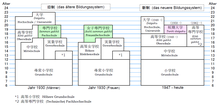Tanki Daigaku
Tanki Daigaku ( Japanese 短期 大学 ; from tanki , German "short duration", and daigaku , "university"; short: Tandai ( 短 大 )) denotes a Japanese form of university . Tanki Daigaku is translated into English as a junior college or community college and in German as a short university , short university or semi-university .
Legal definition
According to §108 of the Japanese School and Education Act (Japanese 学校 教育 法 , Gakkō kyōiku hō ) is a Tanki Daigaku
- a university with the main aim of developing skills necessary for the job or in everyday life (§108 (1); more limited than the aim of Daigaku , according to §83 (1));
- a university with two or three years duration (§108 (2); not four years [medicine / pharmacy: six years] like Daigaku according to §87).
A tanki daigaku is made
- not from gakubu ( 学部 , faculty (s); §108 (4)),
- but only from gakka ( 学科 , section (s); §108 (5)).
A Tanki Daigaku can
- Set up evening courses or distance learning courses (§108 (6)), but
- do not set up graduate schools (master’s / doctoral courses) (§108 (8)).
The graduates of a Tanki Daigaku can obtain the qualification associate degree ( 短期 大学 士 , tanki daigakushi ) (§104 (3), since 2005). You can continue to attend four-year universities (§108 (7)).
Some Tanki Daigaku use advanced courses ( 専 攻 科 , zitō-ka ); Graduates of the advanced courses can obtain the Bachelor's degree (the NIAD-UE awards it; §104 (4) -1).
history
As a result of the Japanese educational reform after the Pacific War , the former secondary schools ( 高等学校 , kōtō gakkō , English higher schools ) and technical schools ( 専 門 学校 , semmon gakkō , English specialized schools ) were converted to the four-year Daigaku (colleges / universities). However, some technical schools did not have enough professors or facilities to obtain Daigaku status. From 1950 these became the Tanki Daigaku . The Tanki Daigaku university type was started as a temporary measure, and has been a permanent system since 1964.
The Tanki Daigaku are attended by more female students than students. In 1971 women made up about 83 percent of the Tanki Daigaku student population , while the Daigaku made up only 18 percent of the student body. Most of the Tanki Daigaku were private institutions specializing in literature, foreign languages, home economics, and nursing science.
Due to some time-consuming subject areas such as B. Nursing Science, many Tanki Daigaku were later elevated to four-year-old Daigaku . In 1971 there were 389 Daigaku and 486 Tanki Daigaku in Japan ; in 2008, 752 Daigaku and 385 Tanki Daigaku .
See also
Individual evidence
- ↑ MEXT : Archived copy ( memento of the original dated August 24, 2010 in the Internet Archive ) Info: The archive link was inserted automatically and has not yet been checked. Please check the original and archive link according to the instructions and then remove this notice. , accessed March 25, 2010.
- ↑ as in the article en: Education in Japan # Structure
- ↑ Archived copy ( memento of the original from April 5, 2010 in the Internet Archive ) Info: The archive link was inserted automatically and has not yet been checked. Please check the original and archive link according to the instructions and then remove this notice. , accessed March 25, 2010.
- ↑ Archived copy ( memento of the original from July 1, 2018 in the Internet Archive ) Info: The archive link was inserted automatically and has not yet been checked. Please check the original and archive link according to the instructions and then remove this notice. , accessed March 25, 2010.
- ↑ Archived copy ( memento of the original from July 1, 2018 in the Internet Archive ) Info: The archive link was inserted automatically and has not yet been checked. Please check the original and archive link according to the instructions and then remove this notice. , accessed March 25, 2010.
- ↑ MEXT: Archived copy ( memento of the original dated August 24, 2010 in the Internet Archive ) Info: The archive link was inserted automatically and has not yet been checked. Please check the original and archive link according to the instructions and then remove this notice. , accessed March 25, 2010.
- ↑ a b MEXT: Archived copy ( memento of the original from August 26, 2010 in the Internet Archive ) Info: The archive link was inserted automatically and has not yet been checked. Please check the original and archive link according to the instructions and then remove this notice. , accessed March 25, 2010.
- ↑ MEXT: Table 7-7. to archived copy ( memento of the original from August 18, 2010 in the Internet Archive ) Info: The archive link was inserted automatically and has not yet been checked. Please check the original and archive link according to the instructions and then remove this notice. , accessed March 25, 2010.
- ↑ MEXT: Higher Education in Japan (2009) ( Memento of the original dated December 29, 2009 in the Internet Archive ) Info: The archive link was inserted automatically and has not yet been checked. Please check the original and archive link according to the instructions and then remove this notice. , PDF in English, page 4, accessed March 25, 2010.
Web links
- 学校 教育 法 (The Japanese School Law) - Japanese
